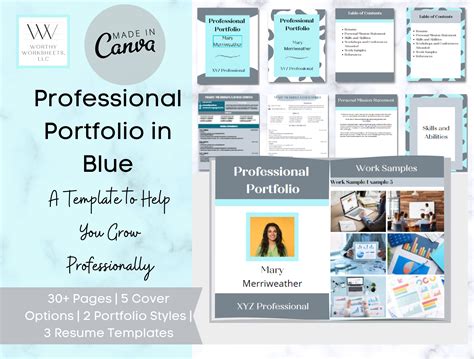
Resume Portfolio Folder: The Ultimate Guide to Creating a Professional and Impressive Presentation
Navigating the competitive job market requires a resume that effectively captures the attention of potential employers. A well-organized and visually appealing resume portfolio folder can significantly enhance your chances of making a positive first impression.

The Importance of a Resume Portfolio Folder
- Enhances Professionalism: A dedicated portfolio folder conveys a sense of professionalism and organization. It ensures that your resume, cover letter, and other supporting documents are presented in a cohesive and polished manner.
- Protects and Organizes: By enclosing your documents in a folder, you protect them from damage or creases during transportation. It also allows you to easily keep track of your materials and present them in a structured order.
- Makes a Lasting Impression: A well-crafted portfolio folder not only showcases your resume but also reflects your personality and attention to detail. It can leave a lasting impression on recruiters and hiring managers.
Step-by-Step Guide to Creating a Resume Portfolio Folder
1. Choose a Folder Design:
- Consider the industry you’re applying to and the company’s culture.
- Opt for a design that is professional, visually pleasing, and aligns with your personal brand.
- Choose high-quality materials that will withstand wear and tear.
2. Organize Your Documents:
- Resume: Place your resume at the front of the folder. Ensure it is updated, well-written, and tailored to each job application.
- Cover Letter: Include a cover letter that highlights your most relevant skills and experiences.
- Portfolio: Showcase your work samples, certifications, or awards if applicable.
- References: Provide a separate list of professional references upon request.
3. Finalize Presentation:
- Insert all documents into the folder in a logical order.
- Place a small clip or brad to keep the materials secure.
- Consider adding a business card or contact information page to the back of the folder.
Types of Resume Portfolio Folders
There are various types of resume portfolio folders available:
- Leather: Professional and durable, suitable for corporate environments.
- Polypropylene: Lightweight and cost-effective, ideal for students or job seekers on a budget.
- Cardboard: A budget-friendly option for short-term use or high-volume applications.
- Custom: Designed specifically to meet your needs, allowing for branding and personalization.
Customization Options
- Branding: Emboss or print your name, logo, or company information on the folder.
- Personalization: Choose a design or color that reflects your personality or career goals.
- Additional Features: Consider adding dividers, pockets, or other features to enhance functionality.
Measurement Considerations
- Standard Resume: 8.5 inches x 11 inches
- Common Folder Sizes: 9.25 inches x 12.5 inches (letter size) or 8.5 inches x 14 inches (legal size)
- Portfolio Size: Varies depending on the type and amount of materials included
Tips for Success
- Proofread Carefully: Check for any errors in grammar, spelling, or formatting.
- Use High-Quality Paper: Opt for professional-grade paper to enhance the appearance of your documents.
- Consider Digital Options: Some industries prefer digital portfolios. Create a website or PDF version for easy sharing.
- Stay Updated: Keep your portfolio up-to-date with your latest work and accomplishments.
Additional Applications
Beyond job applications, resume portfolio folders can be used for various purposes:
- Presentation Materials: Showcase project proposals, sales presentations, or business plans.
- Marketing Collateral: Distribute marketing materials, brochures, or product samples.
- Client Portfolios: Highlight work completed for clients or showcase your skills to potential partners.
- Educational Resources: Organize handouts, assignments, or research materials for students or professionals.
Examples
Here are some examples of industries where resume portfolio folders are particularly valuable:
- Creative Arts: Design, photography, writing, music
- Architecture and Engineering: Project proposals, sketches, blueprints
- Education: Teaching materials, lesson plans, student portfolios
- Finance and Banking: Financial statements, pitch decks, investment proposals
- Non-Profit Organizations: Grant proposals, annual reports, programmatic updates
Conclusion
A well-crafted resume portfolio folder is an essential tool for showcasing your professional identity and making a strong first impression. By following the steps and tips outlined in this guide, you can create a portfolio that enhances your job search efforts and positions you for success.











